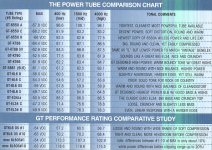I've been experimenting with different brand tubes and have found that some brands have a min bias end range that is hotter than others. Some tube resellers use a numbering system to denote this others a color code. In GT case, their #1 rating would be able to bias lower than than #10 rating. Some circuits can handle hotter biasing tubes , others need cooler biasing tubes. Bascially, I have found that you can't get a hot biasing tube to work in a circuit that needs a cooler tube. But you can use cool tubes in hotter circuits. I like this chart because it provides some example bias voltages which in some cases vary quite a bit between say an A, B, or C tube. In real world, a 6550A has a lower bias starting point than say a 6550 WE.
Attachments
Groove Tubes tests and sorts tubes for guitar amp use. They used to state that the number related to the distortion characteristics of their tubes. A #1 tube would distort at say half throttle, while a #10 tube would go to 3/4 throttle before distorting in the same amp. This was about 10 years ago (maybe more). It looks like they have gotten a bit more scientific about it now. You want to stay near the #10 end of the range for a HiFi amp, but I was making guitar amps then, so some amps got #2's.
- Status
- This old topic is closed. If you want to reopen this topic, contact a moderator using the "Report Post" button.
